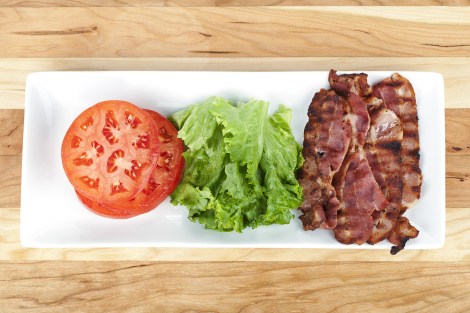I have now gone 30 days without eating meat. Well, that is not entirely true: The other day, I was making my boyfriend a bacon, lettuce, and tomato sandwich and without even thinking about it, I ate a piece of bacon.
It was pretty small — about the size of a postage stamp. But I ate it.
I told a friend, and he asked me if I felt guilty. I have to say I really didn’t. Maybe I am too easy on myself, but I am conducting a sort of experiment, and what I do or don’t do is just data, results, information. The information here was: I really wanted to not want to put the bacon in my mouth. And I clearly wasn’t there yet. So it was probably a good thing that this week I was focusing on the part of the book Eating Animals that describes how pigs are killed. (I’m saving cows for next week, because I am going to compare grass-fed and grain-fed, which is a big and complicated topic.)
Without further ceremony, then, let’s get straight into how Jonathan Safran Foer describes the pork industry in Eating Animals. Again — I’m focusing on commercial pig farms. There is a large section of the book about places like Niman Ranch where yes, indeed, pigs have much better lives and deaths than they do on most pig farms. But this bacon wasn’t Niman Ranch bacon; it was whatever brand from the supermarket. And, without thinking, I ate a piece of it. And I served it to someone.
Here are a few things Foer tells us about how this bacon came to be:
- Pregnant sows are kept in crates. These crates are so small that the sow can’t even turn around. Pigs like to eat and shit in separate places — not unlike humans. But an animal in a crate is forced to lie down and sleep in its own feces and urine, and when these crates are stacked, the feces and the urine simply goes through their cage and lands on the animals beneath them.
- Typically about a 10th of all piglets born are runts. Runts are seen as a waste of food and space, and farm workers kill them with a practice called thumping, which means they pick the animal up by its hind legs and bash its head against the floor. (Now, granted, runts do not survive in the wild either. More on this later.)
- Pigs and cows are killed pretty much the same way: They are shocked on the top of the head with a stun gun, which is supposed to render them unconscious. (This fails about 20 percent of the time, in which case they are killed with a bolt knocker — a piece of steel pushed into the top of their head.) Then they are hung up by their feet, their throats are cut, and their blood pours out. After this they are scalded and then blowtorched, to get any hair off of them that scalding didn’t manage to take care of.
- Pigs are known to be rather intelligent animals. It is thus not surprising that in 1992 the National Pork Producer’s council reported that 10 percent of pigs were so stressed that the meat they produced was no good. There’s a name for the meat that comes from stressed pigs: PSE pork, or “pale soft exudative.” The industry tried to breed the stress gene responsible for this out of the population, but problems with PSE pork just got worse. By 2002, the American Meat Science Association estimated that 15 percent of slaughtered pigs had PSE flesh.
After reading the part about the runts, I was curious about how runts died when they weren’t killed on factory floors. Sure enough, it is not a good ending: Their mothers don’t feed them, and they are teased and pestered by their heartier brothers and sisters, and then, mostly, they starve to death. This is hardly a nice way to die, and it certainly does not become more pleasant for being “natural.”
People often defend meat eating by saying that animals die anyway or that nature is cruel, and this is certainly true. But it will never not be true that death happens and is often cruel. What I find myself noticing here is not so much how the animals die but how they live. Most animals that are raised to be eaten spend hours in misery, and those hours are spent this way for our pleasure. (Foer says something similar in his book.)
I am, so far, not succeeding in squelching my desire to eat meat. The stuff still appeals to me, obviously, or I wouldn’t have put that piece of bacon in my mouth. Yes, I did so before I’d read the pig chapters very closely. But the idea of bacon, even though I haven’t eaten it again, is still far from disgusting to me. Even after reading all that.
And I was feeling so good about being so quickly grossed out by chicken and fish! It occurs to me that maybe I just don’t like chicken and fish as much as I like bacon.
It is dawning on me that for now, no matter what I know, or how much I learn, if I can stick to not eating meat it is probably going to have to be a decision, something I force on myself. The thing is, I think eating factory-farmed meat is wrong, and that is a long way from where I was when I started this. But my desire to eat meat has not gone away, either.
So now I say I despise cruelty against animals, and insist that I am affected by it; what does it mean that I could still feasibly eat them?




